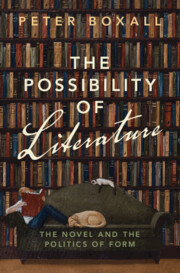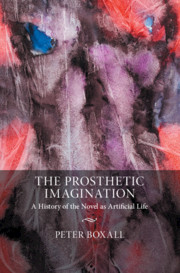85 results

The Possibility of Literature
- The Novel and the Politics of Form
- Coming soon
-
- Expected online publication date:
- July 2024
- Print publication:
- 05 September 2024
-
- Book
- Export citation
Chapter 9 - Utopia after American Hegemony
-
-
- Book:
- The Cambridge Companion to American Utopian Literature and Culture since 1945
- Published online:
- 09 May 2024
- Print publication:
- 16 May 2024, pp 167-184
-
- Chapter
- Export citation
8 - ‘A More Sophisticated Imitation’
- from Part II - Literature, Music, and Film
-
-
- Book:
- The Cambridge Companion to Kazuo Ishiguro
- Published online:
- 16 March 2023
- Print publication:
- 23 March 2023, pp 123-137
-
- Chapter
- Export citation
Chapter 18 - Neoliberalism
- from Part III - 1989–2000: Rights and Activisms
-
-
- Book:
- The Cambridge Companion to Twentieth-Century Literature and Politics
- Published online:
- 01 December 2022
- Print publication:
- 15 December 2022, pp 307-322
-
- Chapter
- Export citation
Part III - The Manufactured Body: From Wollstonecraft to Stoker
-
- Book:
- The Prosthetic Imagination
- Published online:
- 18 September 2020
- Print publication:
- 03 September 2020, pp 147-222
-
- Chapter
- Export citation
Part IV - The Modernist Body: From James to Beckett
-
- Book:
- The Prosthetic Imagination
- Published online:
- 18 September 2020
- Print publication:
- 03 September 2020, pp 223-284
-
- Chapter
- Export citation
Part II - The Colonial Body: From Behn to Goethe
-
- Book:
- The Prosthetic Imagination
- Published online:
- 18 September 2020
- Print publication:
- 03 September 2020, pp 71-146
-
- Chapter
- Export citation
Contents
-
- Book:
- The Prosthetic Imagination
- Published online:
- 18 September 2020
- Print publication:
- 03 September 2020, pp vii-viii
-
- Chapter
- Export citation
Chapter 1 - Fiction, the Body and the State
- from Part I - The Body and the Early Modern State: From More to Cavendish
-
- Book:
- The Prosthetic Imagination
- Published online:
- 18 September 2020
- Print publication:
- 03 September 2020, pp 27-70
-
- Chapter
- Export citation
Epigraph
-
- Book:
- The Prosthetic Imagination
- Published online:
- 18 September 2020
- Print publication:
- 03 September 2020, pp vi-vi
-
- Chapter
- Export citation
Chapter 9 - Prosthetic Worlds in the Twenty-First-Century Novel
- from Part V - The Posthuman Body: From Orwell to Atwood
-
- Book:
- The Prosthetic Imagination
- Published online:
- 18 September 2020
- Print publication:
- 03 September 2020, pp 319-354
-
- Chapter
- Export citation
Introduction
-
- Book:
- The Prosthetic Imagination
- Published online:
- 18 September 2020
- Print publication:
- 03 September 2020, pp 1-24
-
- Chapter
- Export citation
Dedication
-
- Book:
- The Prosthetic Imagination
- Published online:
- 18 September 2020
- Print publication:
- 03 September 2020, pp v-v
-
- Chapter
- Export citation
Copyright page
-
- Book:
- The Prosthetic Imagination
- Published online:
- 18 September 2020
- Print publication:
- 03 September 2020, pp iv-iv
-
- Chapter
- Export citation
Chapter 3 - Organic Aesthetics from Richardson to Goethe
- from Part II - The Colonial Body: From Behn to Goethe
-
- Book:
- The Prosthetic Imagination
- Published online:
- 18 September 2020
- Print publication:
- 03 September 2020, pp 117-146
-
- Chapter
- Export citation
Acknowledgements
-
- Book:
- The Prosthetic Imagination
- Published online:
- 18 September 2020
- Print publication:
- 03 September 2020, pp x-xii
-
- Chapter
- Export citation

The Prosthetic Imagination
- A History of the Novel as Artificial Life
-
- Published online:
- 18 September 2020
- Print publication:
- 03 September 2020
Chapter 5 - Strange Affinity: Gothic Prosthetics from Shelley to Stoker
- from Part III - The Manufactured Body: From Wollstonecraft to Stoker
-
- Book:
- The Prosthetic Imagination
- Published online:
- 18 September 2020
- Print publication:
- 03 September 2020, pp 201-222
-
- Chapter
- Export citation
Chapter 2 - Economies of Scale from Aphra Behn to Sarah Scott
- from Part II - The Colonial Body: From Behn to Goethe
-
- Book:
- The Prosthetic Imagination
- Published online:
- 18 September 2020
- Print publication:
- 03 September 2020, pp 73-116
-
- Chapter
- Export citation
Notes
-
- Book:
- The Prosthetic Imagination
- Published online:
- 18 September 2020
- Print publication:
- 03 September 2020, pp 355-382
-
- Chapter
- Export citation



